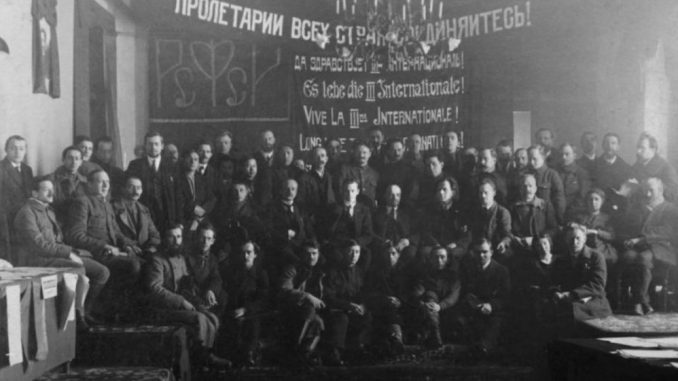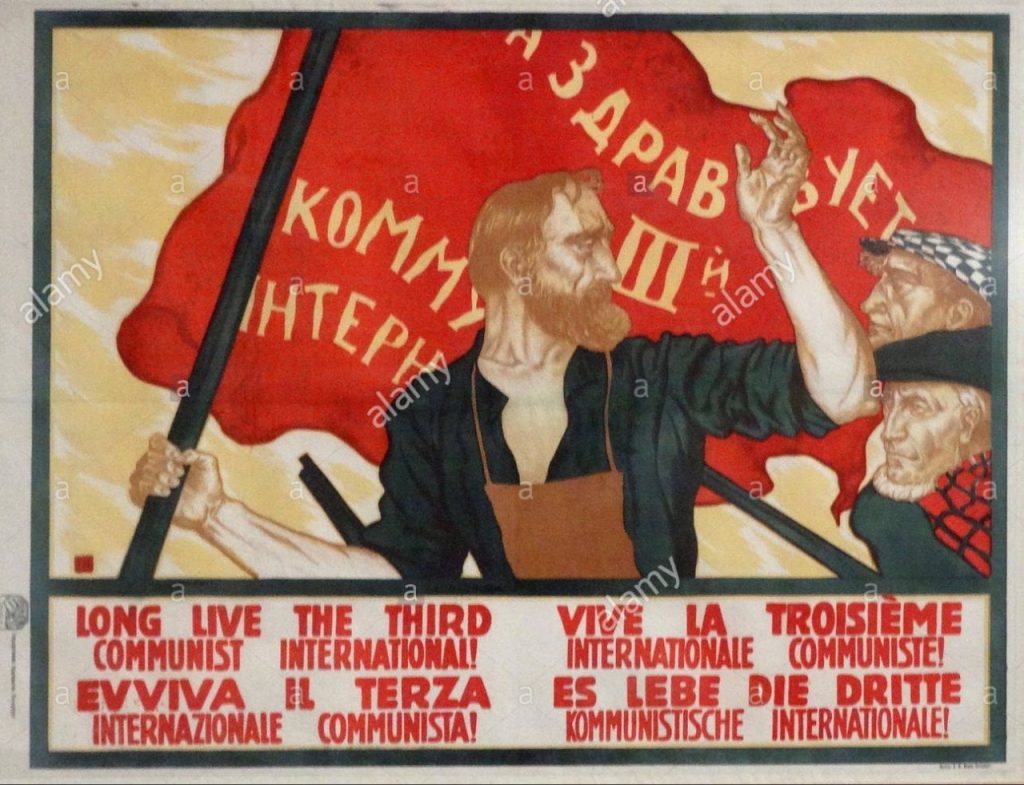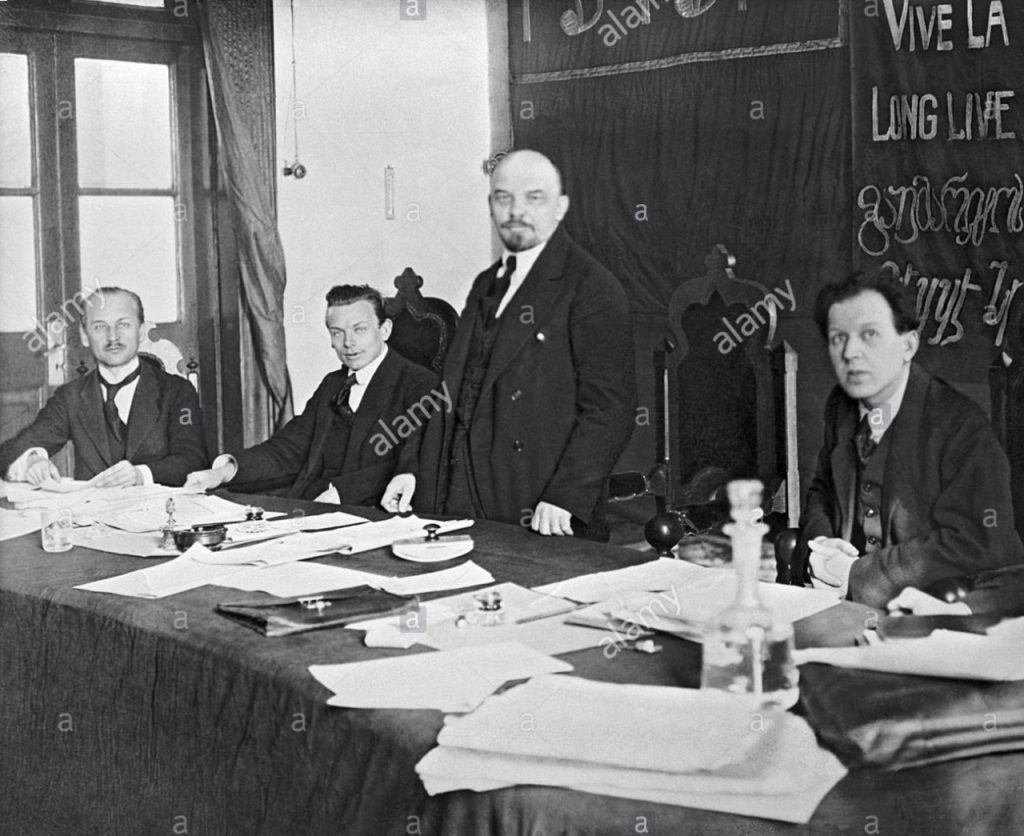
By Emilio Poliak
A hundred years ago, on June 22nd, 1921, delegates of more than 50 parties from different parts of the world met in Moscow. At the time of the celebration of the Congress, the first revolutionary wave unleashed towards the end of the World War had come to an end and the revolution had only managed to succeed and consolidate itself in Russia. The resolutions of the Congress were significantly important to face the new situation and still provide a necessary guide for the task of building strong revolutionary parties with mass influence.
The inter-imperialist war exposed the decay of the capitalist system and produced revolutionary actions that spread throughout Europe, challenging the bourgeoisie and placing the socialist revolution on the agenda in Germany, Hungary, Czechoslovakia, Italy and other countries. In none of them did it succeed.
The bourgeoisie was able to overcome this first threat thanks to the collaboration of the social democracy, consolidated as an agent of the bourgeoisie and guardian of the capitalist system. Up to that moment, the revolutionary sectors were no more than tendencies within the old socialist parties and only in the heat of the revolutionary process itself were independent communist parties created. Their immaturity and the betrayal of the reformists allowed the bourgeoisie to regain control and maintain its domination, albeit in an unstable manner.

From the struggle against opportunism to the struggle against sectarianism
The first congresses were held in the framework of that first revolutionary upsurge and had as their main objective to programmatically and organizationally build the new communist parties, setting themselves apart from social democracy and also from the centrists who were approaching the International but without abandoning their reformist conceptions. The Thesis on bourgeois democracy and the dictatorship of the proletariat or the 21 Conditions of admission of the parties to the Communist International pursued this objective. The split with reformism originated, however, the rise of ultra-left currents and tendencies which also represented an obstacle to the formation of a leadership which could lead the masses towards the seizure of power.
You may be interested in: The soviets. History and debates
They diluted the historical perspective -the exhaustion of bourgeois democracy- in concrete reality, ignoring that the majority of the workers and mass movement had not yet reached that conclusion. Instead of accompanying that experience, they denied the participation of the communists in parliament and in the reformist unions, as well as the adoption of tactics that would allow the small communist groups to link up with the mass movement. In this way, what they achieved was to isolate themselves from the workers’ movement and allow the counterrevolutionary currents to maintain their influence. As part of the battle against these conceptions, Lenin published in 1920 his book “Left-Wing” Communism: An Infantile Disorder.
In March 1921, the ultra-left line had its expression in Germany when the Communist Party launched a premature insurrection without the support of the majority of the workers’ movement, which was defeated and caused a great setback in one of the strongest parties of the International. The “theory of the offensive”, the basis of the line followed by the German communists and promoted by some leaders of the International such as Bela Kun, Zinoviev and Bukharin, consisted in provoking actions against the bourgeois state and its repressive forces, combining them with communist propaganda, considering that in this way the masses would launch themselves into insurrection.
Towards the conquest of power, through the prior conquest of the masses
The Congress was crossed by the debates on the March action in Germany and the characterization of the new political situation. If the first two congresses had been held when the European upsurge seemed to lead to the imminent seizure of power in several countries of the continent, by June 1921 it was clear that victory was more complex than earlier supposed and a triumph of the revolution was not an immediate perspective. The bourgeoisie had shown more strength than expected to resist the assault of the workers’ movement and was counting on the support of social democracy, which continued to be the majority leadership of the working class. In that context, ultra-left actions would only make the communists retreat. On the contrary, it was necessary to know how to analyze the concrete moments of the class struggle in order to know how to distinguish a revolutionary situation from another which was not revolutionary and to equip oneself with the correct tactics and policies according to that analysis. That is why the official documents, as well as the interventions of Lenin and Trotsky, pointed out that the center of the orientation should be placed in the struggle for the conquest of communist influence in the majority of the workers and mass movement. This is how the Theses on the tactics proposed to the Congress put it: “The most important task of the Communist International at present is to gain decisive influence over the majority of the working class and to lead its decisive sectors into struggle. The economic and political situation is objectively revolutionary, and can give rise to an acute revolutionary crisis at any moment – be it a mass strike, a colonial uprising, a new war, or even a major parliamentary crisis. However, the majority of the working class is not yet subject to Communist influence.” The struggle for power had to be preceded by a period of preparation which consisted not only in propaganda, but in intervening in the daily struggles of the working class for its demands, fighting in them to acquire a decisive influence. Faced with the objections of a sector of the Congress, Lenin responded: “All objections against raising partial demands of this type, all accusations of reformism under the pretext of these partial struggles derive from that same incapacity to understand the real conditions of revolutionary action which was already manifested in the opposition of certain communist groups to the participation in the unions and to the use of parliamentarism. It is not a question of always preaching to the proletariat the final objectives but of moving forward the concrete struggle which is the only one that can lead it to fight for those final objectives.”

The United Front
The capitalist economic offensive that increased the misery of the masses and the need to fight to improve living standards, strengthened the aspiration of the working to unite all the proletarian forces to confront the bourgeoisie in better conditions. The task of the revolutionaries consisted then in proposing to the reformist leaderships unity for a common struggle for a program that would respond to the workers’ needs. In this way, apart from taking into account the desire of unity of the masses to carry out an effective combat, it gave proof of the vacillations and betrayals of the bureaucratic and reformist leaderships in the real experience of class struggle, increasing the communist influence within the working class. For this objective the Communist Party had to maintain its political and organizational independence, as well as freedom of criticism. In a document of 1922, referring to the United Front, Trotsky pointed out: ” If the Communist Party did not seek for organizational avenues to the end that at every given moment joint, co-ordinated action between the Communist and the non-Communist (including the Social-Democratic) working masses were made possible, it would have thereby laid bare its own incapacity to win over – on the basis of mass action – the majority of the working class. It would degenerate into a Communist propaganda society but never develop into a party for the conquest of power. (…) Unity of front consequently presupposes our readiness, within certain limits and on specific issues, to correlate in practice our actions with those of reformist organizations, to the extent to which the latter still express today the will of important sections of the embattled proletariat. (…)We broke with the reformists and centrists in order to obtain complete freedom in criticizing perfidy, betrayal, indecision and the half-way spirit in the labour movement. For this reason any sort of organizational agreement which restricts our freedom of criticism and agitation is absolutely unacceptable to us. We participate in a united front but do not for a single moment become dissolved in it. We function in the united front as an independent detachment. It is precisely in the course of struggle that broad masses must learn from experience that we fight better than the others, that we see more clearly than the others, that we are more audacious and resolute. In this way, we shall bring closer the hour of the united revolutionary front under the undisputed Communist leadership.”
The Theses on tactics were approved with the opposition of a minority sector. The Fourth Congress, held a year later -the last in Lenin’s lifetime- would ratify and deepen the elaborations on the United Front. Already with Stalin dominating the International, these and other important elaborations and resolutions voted during the first four congresses would be erased from the political action of the Communist Parties, which would oscillate between the sectarianism of the Third Period and the opportunism of the Popular Fronts, according to the needs of the bureaucracy more than those of the workers’ movement.
One hundred years later
The capitalist system showed its decay more than a century ago. The current economic, social, environmental and health crisis ratifies it. While a minority accumulates fabulous profits, millions are submerged in misery. The pandemic has exposed an irrational system that condemns millions to death while guaranteeing the profits of a few capitalists. The rebellions that are sweeping the entire planet show the strength of the masses and question the capitalist system. However, historical experience shows that victory requires more than strength and determination: it requires the leadership of revolutionary parties, as part of an international revolutionary organization. The rebellions sweeping the world, the crisis of the system and the accelerated experience of the workers’ movement with reformist or neo-reformist organizations create the conditions to build such parties. The lessons of the Communist International are of immense value. The struggle and delimitation with reformism is as important as the need to have tactics towards the bureaucratic and reformist leaderships, and fundamentally towards the new phenomena that arise in the real processes of struggle. This is key to accelerate the experience of the masses with these leaderships. The sectarian currents, by refusing to apply these types of tactics, end up favoring the influence of those leaderships over the mass movement and like opportunists, hinder the construction of strong revolutionary parties, and therefore the triumph of the socialist revolution.








